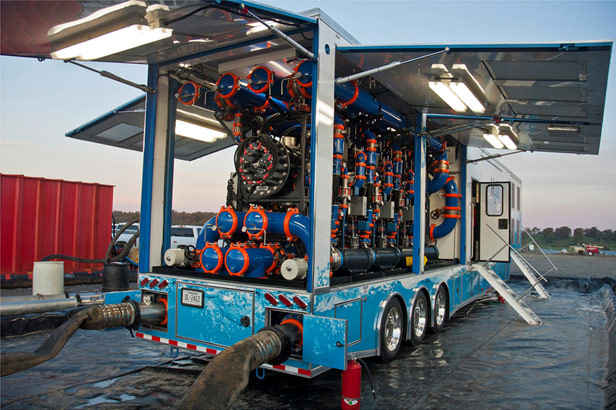Using Ozone to Clean Up Fracking

The oil and natural-gas boom in the United States—driven by water-intensive hydraulic fracturing technology (see “Natural Gas Changes the Energy Map”)—is creating demand for better water-treatment technologies. Now Ecosphere Technologies has developed a process that is helping producers recycle water and eliminate the use of some of the chemicals involved in treating water for fracking.
Vast amounts of water are needed to fracture underground formations and release natural gas (see “Can Fracking Be Cleaned Up?”). A single well uses 15 million liters of water, and thousands of wells have been drilled or permitted in the United States. The sheer volume of water poses a problem in drought-stricken areas, such as the Eagleford shale deposits in Texas. The other problem is wastewater—10 to 50 percent of the water used for fracking flows back out again, and is contaminated with the chemical additives used in fracking as well as with salts, metals, and sometimes radioactive materials that the water picks up underground. In places such as Pennsylvania, there’s no easy way to dispose of this water, since the geology isn’t amenable to deep underground storage.

Ecosphere’s process replaces the biocides and descaling agents typically used in fracking water with an ozone-based treatment. Ozone itself isn’t benign, but Ecosphere produces it on site, so it doesn’t have to be transported, which reduces the chance of spills, the fuel needed for transport, and the wear and tear on roads—a major problem for communities with large fracking operations. The process lets well operators recycle water, reducing the total amount consumed and the amount of waste material that needs to be disposed of.
The use of ozone to treat water isn’t new, but it hasn’t been used much in part because it’s expensive. Ecosphere has found ways to reduce the amount of ozone needed by 90 percent. It uses a combination of approaches. First it flows water through proprietary structures that cause tiny bubbles to form and collapse—which is called cavitation. It also uses ultrasound to create more cavitation. In both cases, this breaks up biological contaminants in the water, making the ozone more effective, and creates free radicals that themselves help disinfect the water. The final step is to run an electrical current through the water, which causes some of the salts in the water to precipitate, reducing scaling. The process is cheaper than some other alternatives, such as UV treatment and desalination, the company says.
There’s a limit to how much Ecosphere’s process can reduce water use, says James Bolander, a senior vice president at Southwestern Energy, a fracking company that uses Ecosphere’s technology. In some cases, it can treat all of the water that flows back out of a fracking well. But most of the water used in fracking stays down in the well, he says, and that needs to be replaced with more fresh water for the next well.
Keep Reading
Most Popular
Large language models can do jaw-dropping things. But nobody knows exactly why.
And that's a problem. Figuring it out is one of the biggest scientific puzzles of our time and a crucial step towards controlling more powerful future models.
How scientists traced a mysterious covid case back to six toilets
When wastewater surveillance turns into a hunt for a single infected individual, the ethics get tricky.
The problem with plug-in hybrids? Their drivers.
Plug-in hybrids are often sold as a transition to EVs, but new data from Europe shows we’re still underestimating the emissions they produce.
Stay connected
Get the latest updates from
MIT Technology Review
Discover special offers, top stories, upcoming events, and more.